Last Updated on June 18, 2019 by Soumya
One look at my header image and you will probably think of the Bayon Temple of Cambodia – the very famous one with Buddha faces carved all around. What if I say this isn’t Bayon? It is, in fact, a very close but lesser-known cousin of Bayon, the Temple of Banteay Chhmar in Cambodia.
In December 2018, we decided to visit Cambodia again. We had been smitten by the beauty of Angkor seven years ago. And this time we wanted to explore deeper. We drew up an itinerary that included some iconic, yet forgotten, temples of Cambodia. And Banteay Chhmar figured on the top of our list.
Let’s explore the Banteay Chhmar Temple in a little detail.

The picture above already shows you the extent of ruins. The temple is definitely a history lover’s dream. Banteay Chhmar means the “Citadel of Cats” in the local language. The temple was built in the 12th century by King Jayavarman VII in honor of his son Suryakumara and 4 of his army commanders who died in the battle between Khmers and Chams.
History behind the temple of Banteay Chhmar
A great deal of the battle is represented in the carvings of the wall where you can clearly make out differences between the Khmer and the Cham armies. The battle was fought on both land and water. Crocodiles are seen waiting to feast on dead bodies as soldiers drop into the water after being hit by arrows.
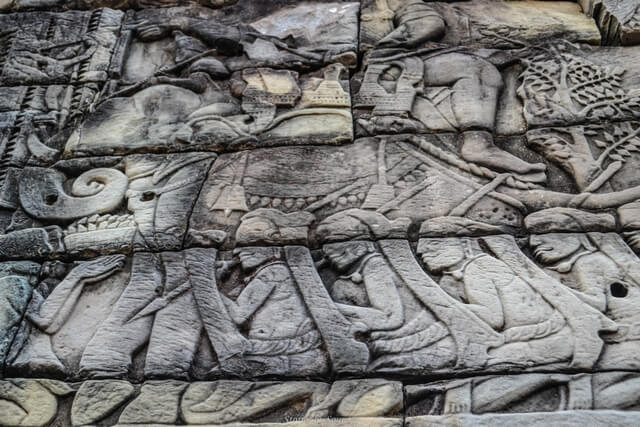
The Chams had no idea how to use the bow and arrow at this point-in-time which led to the Khmer king emerging victorious. However, he lost his son and four key commanders to the battle. Jayavarman VII decided to build the Banteay Chhmar Temple as a poignant reminder of the loss. One of the shrines was believed to hold an image of Suryakumara.
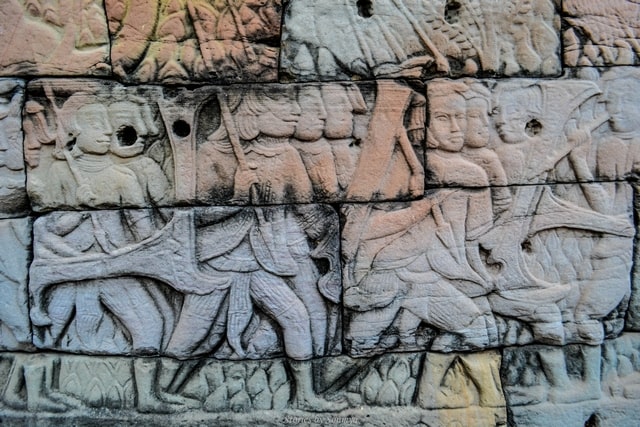
The temples of Banteay Chhmar are older than those of Angkor yet see less than 2000 tourists a year. The reason: nobody really knows about them. The complex temple had been left unused for more than 800 years during which it fell into a bad state of disrepair. Landmines were dumped all over it during the civil war in the 1970s and 80s. And it’s proximity to the Thai border (only 20kms) ensured it was looted and pillaged multiple times. Statues were beheaded and large parts of the outer gallery were removed. Banteay Chhmar suffered more than anyone could ever imagine until all the landmines were cleared and it was eventually put on a restoration schedule and reopened in 2014.
Looking for more temples that have intriguing histories? Do check out our post on the Temple of Preah Vihear that was caught in an ownership tussle between Cambodia and Thailand for several years.
A Brief on The Temple Structure
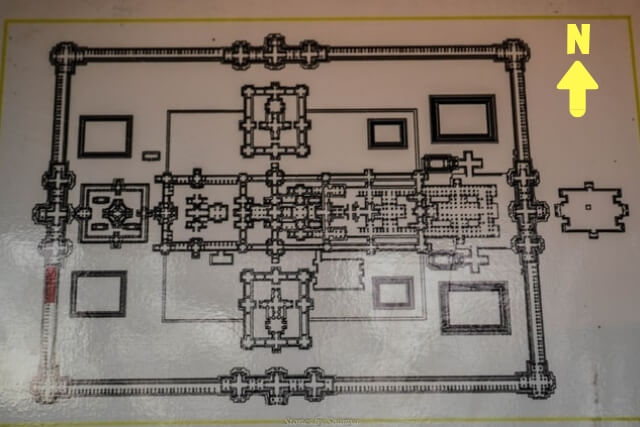
The temple of Banteay Chhmar is massive. It has a huge temple complex along with satellite shrines and a moat surrounding it. The map above shows the original plan of the temple, most of which lies in ruins today. The main entrance is on the east (on the right in the map). As you walk the main road of the town of Banteay Chhmar, you can see the Southern Entrance which is also open to visitors.
The Outer Gallery

The temple is enclosed by an outer gallery that was once covered with immaculately carved bas-reliefs. The east-side gallery has been renovated decently and you can see interesting depictions of battles as well as daily human lives. The rocks are curiously multicolored. Our guide told us that since the temple was made in a haste, the king did not care about what kind of rocks he picked. It eventually led to the mixing of sedimentary rocks of various layers resulting in the rainbow hues. I am not disappointed. It definitely adds another layer of character to the temple.

Banteay Chhmar Temple is unique and famous for housing beautiful carvings of Avalokiteśvaras in the Western Gallery. Such images are not to be found anywhere else. There were 8 of them when the temple was built. 6 were looted/destroyed mostly in the 1990s. Only 2 remain now. And they are a sight for sore eyes!

Bits and pieces of the outer gallery have been restored but a good deal is still in shambles. Huge pieces of the carved wall were plundered and removed in the 1990s. There was this extremely beautiful, still-intact, piece of the covered path in the western side of
Inner Temple
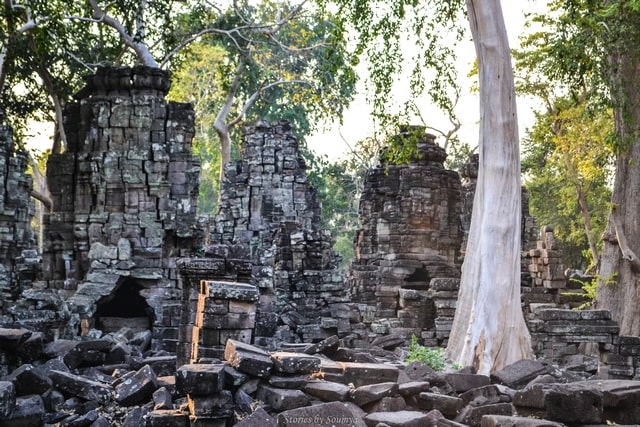
The inner temple complex comprises four major shrines – one dedicated to Buddha and the other three to the Hindu trinity of Brahma-Vishnu-Shiva. Buddha’s shrine is in the middle flanked by the Hindu gods on two sides and behind. It is not unusual to find Lingas and Yonis within some of these shrines.
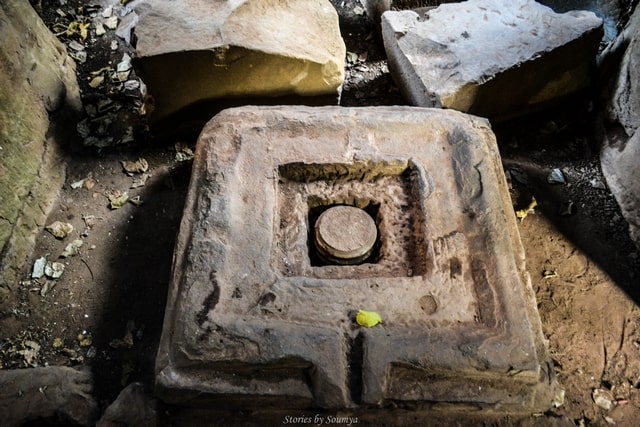
The main temple complex is still not accessible to tourists. You can only walk on a wooden pathway and stop at the right point to appreciate the beauty in front of you.

Rocks lie piled everywhere and it can be difficult to find your way through the ruins without dismantling a huge slab of stone. Therefore, it makes extra sense to have a tour guide to help you traverse the precarious tracks.
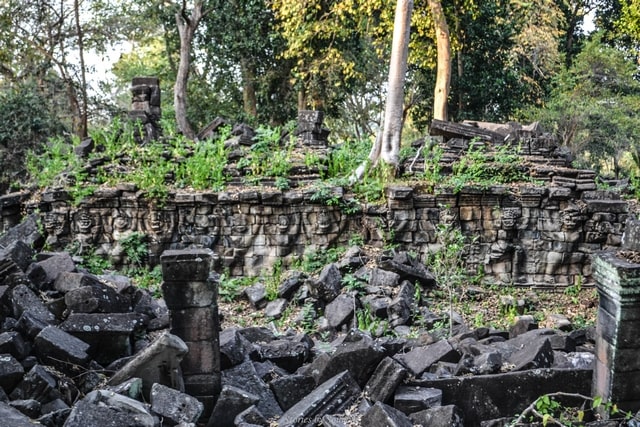
As you walk on the wooden walkway towards the main complex, you will notice, on both sides, the remains of tall walls with lion-like beings carved on them. These huge rooms were apparently libraries – one for Buddhism and another for Hinduism.
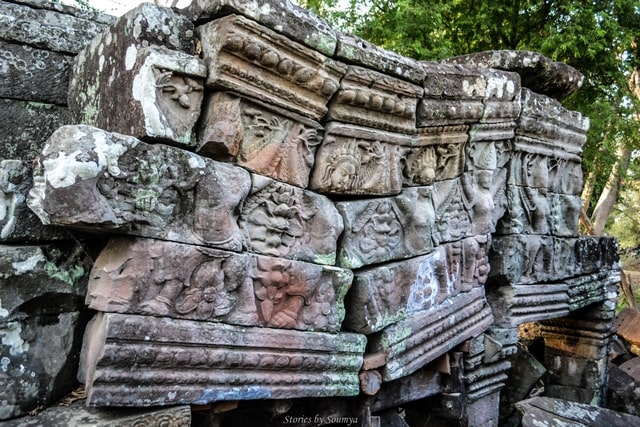
Artistic carvings adorn a number of entrance arches or whatever remains of them. It is not hard to imagine the kind of beautiful place the temple of Banteay Chhmar would have been in its heyday.
Satellite Temples
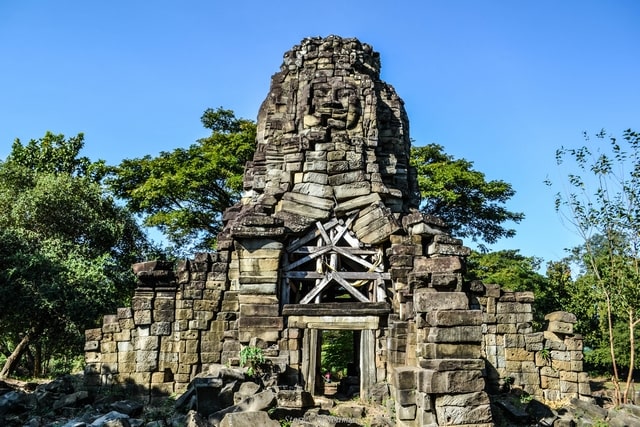
The temple of Banteay Chhmar had nine satellite temples surrounding it. Most of them are in ruins today and have received very little study till date. The only one that has a defined path to get to is the Ta Phrom Temple a little farther away from the main shrine. Again, it pays to have a tour guide to guide you through the jungles in order to get to the right places.
Banteay Chhmar was to me –
A resplendent temple complex with 4 huge temples adorning the center, students poring hard over their books in the libraries, monks wandering about those aesthetically-carved galleries, and devotees thronging the temple from all directions – I was suddenly transported to a world of 1000 years ago!

Logistics
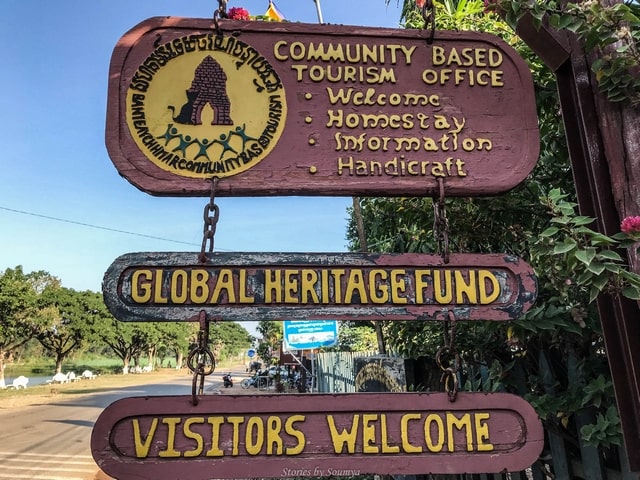
I have only one section on logistics here because I have answered all questions related to how to get to Banteay Chhmar, where to stay, what to eat, how to hire a tour guide, and how to get around in a separate post dedicated just for it. This is because Banteay Chhmar employs sustainable tourism practices through a Community Based Tourism (CBT) formula. The CBT takes care of everything as soon as you arrive in Banteay Chhmar. Please read my post on “Banteay Chhmar Cambodia – A Great Example of Sustainable Tourism” to get all the details.
Sustainable tourism is another reason why Banteay Chhmar is such an attractive upcoming destination. You get to stay with locals, eat food cooked by them, and interact with them on a number of occasions while giving back to the community at the same time.

Banteay Chhmar is rewarded with remarkable isolation. The beauty of the temple lies in the fact that it exists in complete harmony with nature. Creepers recklessly climb the forgotten shrines while giant strangler trees make room for themselves between the rocks. In the midst of all this, you find a tranquil silence only to be interrupted by tweeting birds and rustling leaves. Banteay Chhmar temple is definitely a must-see for those seeking a different Angkorian experience or a tryst with history.
The people who go to Banteay Chhmar are second- or third-time visitors who become addicted and want to explore.
Simon Warrack, Cambodian Temple Researcher to CNN Travel on 26th October, 2017
If you are looking for more temples that exhibit symbiotic relationship with nature, then read about Prasat Pram in our post on the Temples of Koh Ker.
Did you enjoy this post? Did the inner historian in you suddenly make numerous plans? Do you think you will make the trip to Banteay Chhmar Temple the next time you are in Cambodia? Let me know in the comments below and we can get the conversation going.

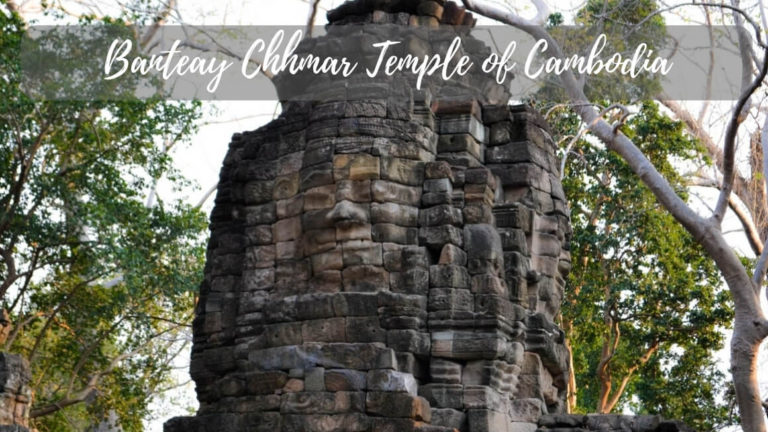
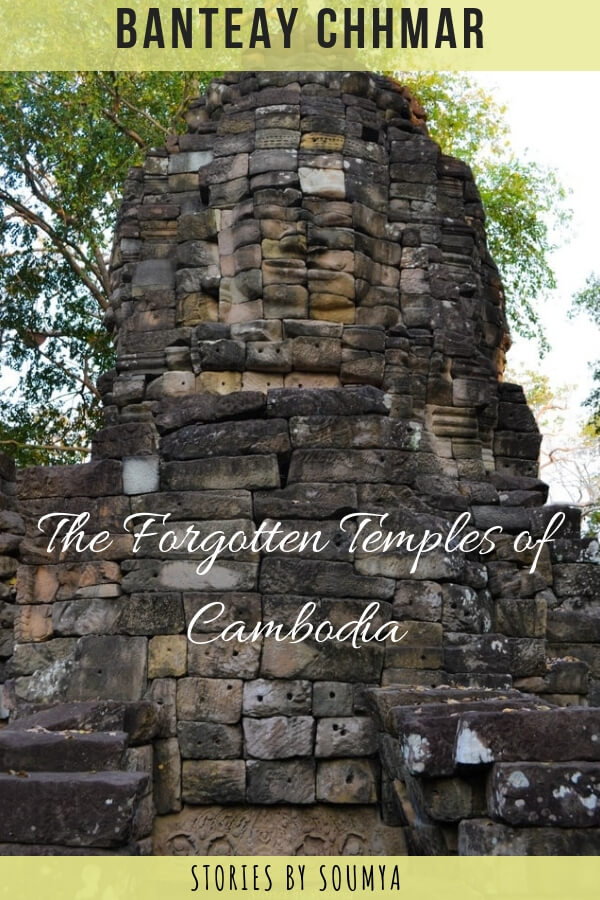

Nice photograph and great description. You have really gone in depth about history of this temple. Wonderful post.
I visited this temple last year and you’re right. Many people don’t know about it and even less know it’s older than Angkor wat. This temple is absolutely stunning and you’ve done a great job describing the whole experience. Thank you for shaekng, this article brought back some nice memories 🙂
Thanks Daniel. It feels good to know someone else who also visited this place. Very off-beat for sure!
I am feeling something danger here how did you are feeling it is temple?
There was no fear at all. These were just rocks that had fallen from their original positions and the tour guide took us very carefully through them.
This temple is truly stunning and you’ve done a great job showing how intricate and beautiful it is. I love how you describe the scenes that are etched into the stone. You transport me there and I can see it with my own eyes. Also, thank you for mentioning that sustainable tourism is important to Banteay Chhmar Temple. This is a topic we need to talk about more!
Absolutely. I am coming up with another post on the sustainable practices and they are doing it really well.
Cambodia!!! Its there at the top on my wishlist. My friends visited there a couple years ago and unfortunately I couldn’t join them.
Indeed there is so much to do there apart from Angkor Vat. Banteay Chhmar Temple looks so so gorgeous!
I totally understand how they want to preserve it and won’t allow tourists in the main area. Pretty similar to Konarak Sun Temple.
That’s true Bhushavali. It’s very beautiful. I hope you get there soon. Tourists aren’t yet allowed in the main area because it’s still a pile of rocks . But I am hoping they restore them soon so that you can see the complete beauty.
Haha, you’re right! My inner historian is now BEGGING to take a trip to Cambodia to check out this temple complex! I also love how isolated it is, and how the trees and vegetation seem to just creep all over it and make themselves at home. It would be an adventure to see this place in its heyday!
You’re so right.
I had been to Cambodia and I haven’t heard of this temple. You’re right – nobody really knows about this. I didn’t know this is a temple complex older than Angkor temple complex. And the colored rocks are something that is very fascinating, plus it has such an interesting history about the war between Khmer and Chams.
I loved the coloured rocks too. And yes amazing history.
Its nice to learn about some of the lesser known destinations in Cambodia. Sometimes those places are even more memorable.
That’s true. Sometimes it is just great to get away from the crowd and venture into some of these lesser known beauties.
I loved the tour of the temple of Banteay Chhmar! It made me feel like I was there with you, exploring the ruins. The temple has quite an interesting history and is definitely a must-see. Cambodia has been on my list for along time now. Hope to be able to explore the Banteay Chhmar Temple in person someday.
I am sure you will love it.
I love that so many places preserve sights like this! I’ve never been to Cambodia but it’s definitely high on my list, along with Vietnam. This looks like an incredible and less touristy place to explore, thanks for sharing!
Cambodia and Vietnam are two amazing countries. I am sure you will have a great time there.
I don’t think I even heard of this temple on my visit to Angkor Wat! It definitely has an unexplored vibe to it. It looks beautiful and definitely off the beaten path!
Absolutely. Very off-beat!
I am always looking at places that are not so touristy so that fits the bill perfectly. I am planning Cambodia and will defintely put Banteay Chhmar on the list. Amazing carvings.
Well, Banteay Chhmar temple is the perfect place for you then.
Wow, what an incredible place. Thanks for sharing!
Thanks Anna. I am glad you liked it.